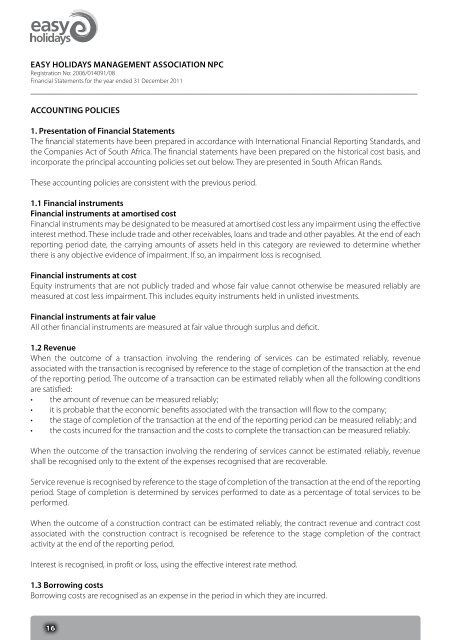15 October 2012 - Easy Holidays
15 October 2012 - Easy Holidays
15 October 2012 - Easy Holidays
You also want an ePaper? Increase the reach of your titles
YUMPU automatically turns print PDFs into web optimized ePapers that Google loves.
EASY HOLIDAYS MANAGEMENT ASSOCIATION NPC<br />
Registration No: 2006/014091/08<br />
Financial Statements for the year ended 31 December 2011<br />
__________________________________________________________________________________________<br />
ACCOUNTING POLICIES<br />
1 . Presentation of Financial Statements<br />
The financial statements have been prepared in accordance with International Financial Reporting Standards, and<br />
the Companies Act of South Africa. The financial statements have been prepared on the historical cost basis, and<br />
incorporate the principal accounting policies set out below. They are presented in South African Rands.<br />
These accounting policies are consistent with the previous period.<br />
1 .1 Financial instruments<br />
Financial instruments at amortised cost<br />
Financial instruments may be designated to be measured at amortised cost less any impairment using the effective<br />
interest method. These include trade and other receivables, loans and trade and other payables. At the end of each<br />
reporting period date, the carrying amounts of assets held in this category are reviewed to determine whether<br />
there is any objective evidence of impairment. If so, an impairment loss is recognised.<br />
Financial instruments at cost<br />
Equity instruments that are not publicly traded and whose fair value cannot otherwise be measured reliably are<br />
measured at cost less impairment. This includes equity instruments held in unlisted investments.<br />
Financial instruments at fair value<br />
All other financial instruments are measured at fair value through surplus and deficit.<br />
1 .2 Revenue<br />
When the outcome of a transaction involving the rendering of services can be estimated reliably, revenue<br />
associated with the transaction is recognised by reference to the stage of completion of the transaction at the end<br />
of the reporting period. The outcome of a transaction can be estimated reliably when all the following conditions<br />
are satisfied:<br />
• the amount of revenue can be measured reliably;<br />
• it is probable that the economic benefits associated with the transaction will flow to the company;<br />
• the stage of completion of the transaction at the end of the reporting period can be measured reliably; and<br />
• the costs incurred for the transaction and the costs to complete the transaction can be measured reliably.<br />
When the outcome of the transaction involving the rendering of services cannot be estimated reliably, revenue<br />
shall be recognised only to the extent of the expenses recognised that are recoverable.<br />
Service revenue is recognised by reference to the stage of completion of the transaction at the end of the reporting<br />
period. Stage of completion is determined by services performed to date as a percentage of total services to be<br />
performed.<br />
When the outcome of a construction contract can be estimated reliably, the contract revenue and contract cost<br />
associated with the construction contract is recognised be reference to the stage completion of the contract<br />
activity at the end of the reporting period.<br />
Interest is recognised, in profit or loss, using the effective interest rate method.<br />
1 .3 Borrowing costs<br />
Borrowing costs are recognised as an expense in the period in which they are incurred.<br />
16


